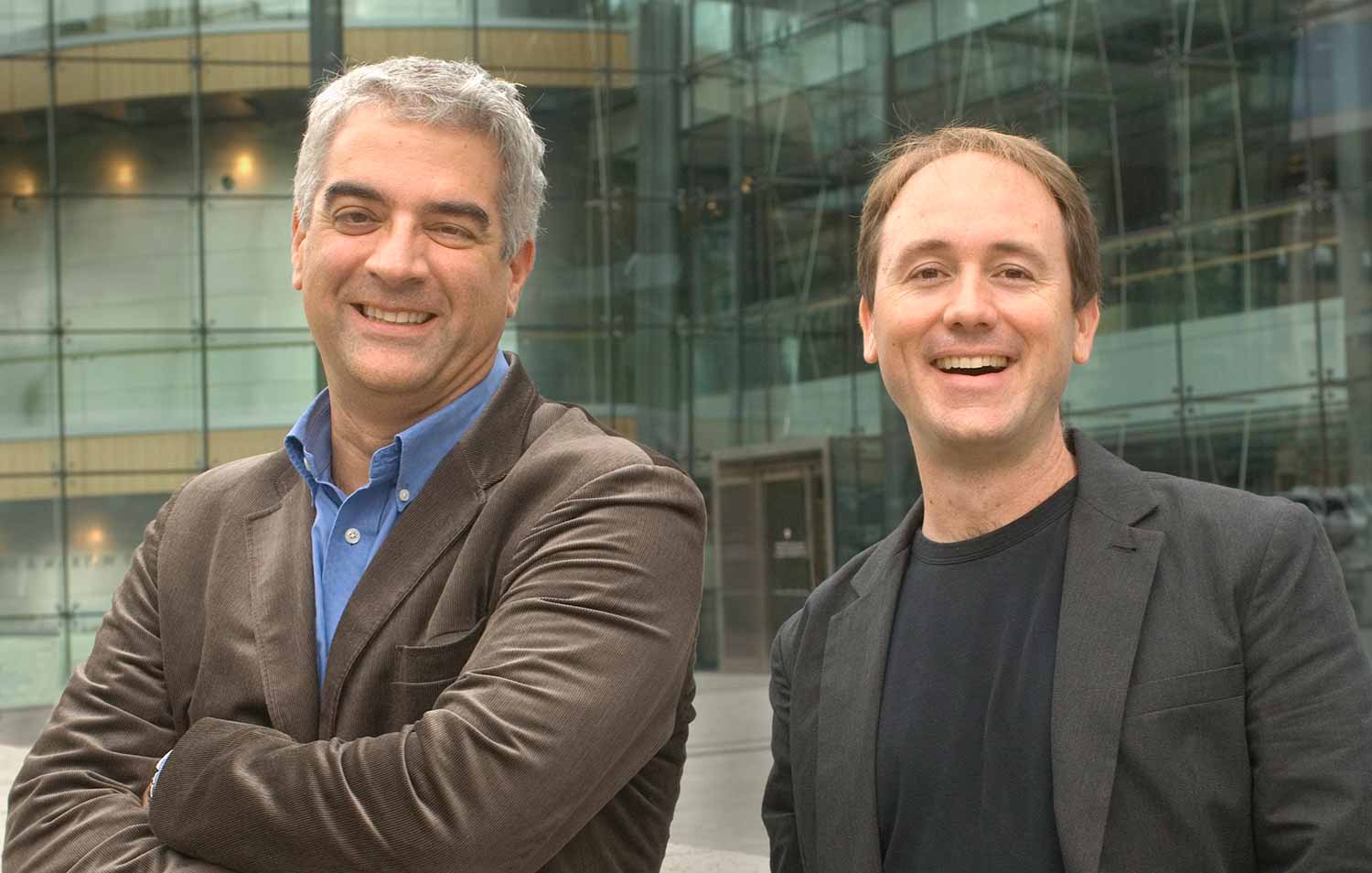Friends Are the Family You Choose: Genome-Wide Analysis Reveals Genetic Similarities Among Friends
Published Date
By:
- Inga Kiderra
Share This:
Article Content

A genome-wide analysis by researchers and friends James Fowler (right) and Nicholas Christakis shows that pairs of friends share genetic similarities. Photo by Liza Green.
If you consider your friends family, you may be on to something. A study from the University of California, San Diego, and Yale University finds that friends who are not biologically related still resemble each other genetically.
Published in the Proceedings of the National Academy of Sciences, the study is coauthored by James Fowler, professor of medical genetics and political science at UC San Diego, and Nicholas Christakis, professor of sociology, evolutionary biology, and medicine at Yale.
“Looking across the whole genome,” Fowler said, “we find that, on average, we are genetically similar to our friends. We have more DNA in common with the people we pick as friends than we do with strangers in the same population.”
The study is a genome-wide analysis of nearly 1.5 million markers of gene variation, and relies on data from the Framingham Heart Study. The Framingham dataset is the largest the authors are aware of that contains both that level of genetic detail and information on who is friends with whom.
The researchers focused on 1,932 unique subjects and compared pairs of unrelated friends against pairs of unrelated strangers. The same people, who were neither kin nor spouses, were used in both types of samples. The only thing that differed between them was their social relationship.
The findings are not, the researchers say, an artifact of people’s tendency to befriend those of similar ethnic backgrounds. The Framingham data is dominated by people of European extraction. While this is a drawback for some research, it may be advantageous to the study here: because all the subjects, friends and not, were drawn from the same population. The researchers also controlled for ancestry, they say, by using the most conservative techniques currently available. The observed genetic similarities go beyond what you would expect to find among people of shared heritage – these results are “net of ancestry,” Fowler said.
Kissing cousins
How similar are friends? On average, Fowler and Christakis find, friends are as “related” as fourth cousins or people who share great-great-great grandparents. That translates to about 1 percent of our genes.
“One percent may not sound like much to the layperson,” Christakis said, “but to geneticists it is a significant number. And how remarkable: Most people don’t even know who their fourth cousins are! Yet we are somehow, among a myriad of possibilities, managing to select as friends the people who resemble our kin.”
In the study, Fowler and Christakis also develop what they call a “friendship score,” which they can use to predict who will be friends at about the same level of confidence that scientists currently have for predicting, on the basis of genes, a person’s chances of obesity or schizophrenia.
Friends with benefits
Shared attributes among friends or “functional kinship” can confer a variety of evolutionary advantages. In the simplest terms: If your friend feels cold when you do and builds a fire, you both benefit.
It is also the case that some traits only work if your friend also has them, Fowler said: “The first mutant to speak needed someone else to speak to. The ability is useless if there’s no one who shares it. These types of traits in people are a kind of social network effect.”
Beyond the average similarities across the whole genome, Fowler and Christakis looked in the study at focused sets of genes. They find that friends are most similar in genes affecting the sense of smell. The opposite holds for genes controlling immunity. That is, friends are relatively more dissimilar in their genetic protection against various diseases.
The immunity finding supports what others have recently found in regards to spouses. And there is a fairly straightforward evolutionary advantage to this, Fowler and Christakis say: Having connections to people who are able to withstand different pathogens reduces interpersonal spread. But how it is that we select people for this benefit of immunity? The mechanism still remains unclear.
Also open to debate and also needing further research is why we might be most similar in our olfactory genes. It could be, Fowler said, that our sense of smell draws us to similar environments. It is not hard to imagine that people who like the scent of coffee, for example, hang out at cafes more and so meet and befriend each other. But the researchers suspect there is more to the story than that.
They note, too, that most likely there are several mechanisms, operating both in concert and in parallel, driving us to choose genetically similar friends.
With a little help from our friends
Perhaps the most intriguing result in the study is that genes that were more similar between friends seem to be evolving faster than other genes. Fowler and Christakis say this may help to explain why human evolution appears to have speeded up over the last 30,000 years, and they suggest that the social environment itself is an evolutionary force.
“The paper also lends support to the view of human beings as ‘metagenomic,’” Christakis said, “not only with respect to the microbes within us but also to the people who surround us. It seems that our fitness depends not only on our own genetic constitutions, but also on the genetic constitutions of our friends.”
The research was supported by grants from the National Institute on Aging (P-01 AG031093) and the National Institute for General Medical Sciences (P-41 GM103504-03).
Share This:
Stay in the Know
Keep up with all the latest from UC San Diego. Subscribe to the newsletter today.



